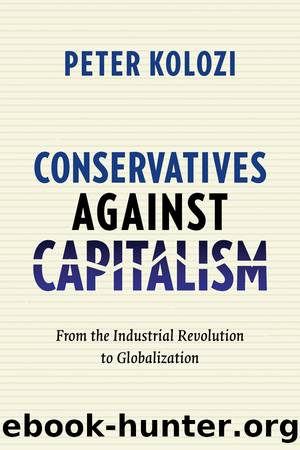Conservatives Against Capitalism by Kolozi Peter;

Author:Kolozi, Peter;
Language: eng
Format: epub
Publisher: Lightning Source Inc. (Tier 3)
THE RUDIMENTS OF A CONSERVATIVE WELFARE STATE
For the postwar conservatives, the restoration of traditional institutions was an attempt to diffuse power away from the state and toward multiple centers of authority. But restoring the function of traditional and intermediate institutions was meant not only to check the power of the state but also to rescue individuals from their individualism and egoism and recover the centrality of traditional religious values. Like their predecessors in the conservative tradition, Viereck, Kirk, and Nisbet believed that traditional institutions ameliorated individualism because they inculcated the values and bonds of kinship, locality, and the Judeo-Christian religion, all of which prevented alienation and anomie. These institutions socialized individuals to value deference to social superiors, thus reinforcing the unequal, hierarchical, natural order and the resulting social stability. Whereas Viereck believed that the state could strengthen intermediate institutions through legislation like the Wagner Act and the Fair Labor Standards Acts, Kirk and Nisbet repudiated the New Deal in its entirety, with Kirk writing that “community cannot be restored through any vaunting program of positive legislation.”106 Despite Kirk’s and Nisbet’s opposition to the New Deal, they offered few concrete policy proposals about how their vision could be achieved or what such a society would look like in a modern context. Kirk proposed an antimodern romanticized inegalitarian petit-bourgeois economy. Nisbet idealized the days before World War I when there was an abundance of churches, voluntary associations, and mutual aid societies with “significant function and role in the larger society.”107
Despite both Kirk’s and Nisbet’s hostility to the New Deal welfare state, neither believed that the authority of traditional institutions would be immediately restored when the state retreated from providing social welfare. Instead, they—and especially Nisbet—crafted the contours of a new relationship between intermediate institutions and the state. According to Nisbet:
[T]he role of [the] political government becomes clear in the democracies. Not to sterilize the normal authorities of associations, as does the total State through a pre-emption of function, deprivation of authority, and a monopolization of allegiance, but to reinforce these associations, to provide, administratively, a means whereby the normal competition of group differences is held within bounds and an environment of law within which no single authority, religious or economic, shall attain a repressive and monopolistic influence—this is the role of government in a democracy.108
The kind of social balance and pluralism that Nisbet and Kirk had in mind required an active government. In The Quest for Community, Nisbet approvingly quoted Frank Tannenbaum on the role of government to ensure “personal freedom and associative authority”:
The road to social peace [wrote Tannenbaum] is the balance of the social institutions, and a wise statesman would strengthen those institutions that seemed to be losing ground, even if he were not addicted to them; for the only way to peace in this world of fallible human nature is to keep all human institutions strong, but none too strong; relatively weak, but not so weak as to despair of their survival.109
While the role of a “statesman” in “strengthening
Download
This site does not store any files on its server. We only index and link to content provided by other sites. Please contact the content providers to delete copyright contents if any and email us, we'll remove relevant links or contents immediately.
| Anarchism | Communism & Socialism |
| Conservatism & Liberalism | Democracy |
| Fascism | Libertarianism |
| Nationalism | Radicalism |
| Utopian |
The Secret History by Donna Tartt(16606)
The Social Justice Warrior Handbook by Lisa De Pasquale(11485)
Thirteen Reasons Why by Jay Asher(7779)
This Is How You Lose Her by Junot Diaz(5753)
Weapons of Math Destruction by Cathy O'Neil(5027)
Zero to One by Peter Thiel(4816)
The Myth of the Strong Leader by Archie Brown(4785)
Promise Me, Dad by Joe Biden(4439)
Stone's Rules by Roger Stone(4412)
Beartown by Fredrik Backman(4403)
How Democracies Die by Steven Levitsky & Daniel Ziblatt(4392)
The Fire Next Time by James Baldwin(4336)
100 Deadly Skills by Clint Emerson(4070)
A Higher Loyalty: Truth, Lies, and Leadership by James Comey(4024)
Rise and Kill First by Ronen Bergman(4008)
The David Icke Guide to the Global Conspiracy (and how to end it) by David Icke(3875)
The Farm by Tom Rob Smith(3869)
Secrecy World by Jake Bernstein(3773)
The Doomsday Machine by Daniel Ellsberg(3725)
